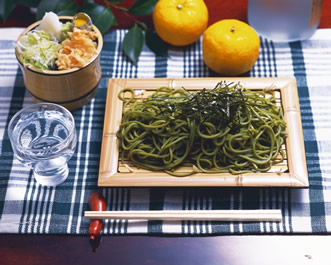Articles on Japan, Links & Reviews
Food in Japan
Cha Soba
Cha Soba is a variety of buckwheat noodles containing green tea, hence the name which translates literally as "tea buckwheat noodles". In order to best retain the color and flavor of green tea, high quality powdered green tea (matcha) is used instead of regular green tea (sencha). With the vivid color and gloss, and smooth texture, the contrast of the sweetness of the buckwheat and bitterness of the green-tea is considered to be quite sublime.
Cha Soba is one variation on regular soba that was originally thought up during the middle of the Edo period when the technique for milling refined "sarashina" soba had been developed, leading to a variety of soba dishes popping up in each region of Japan. Other examples of soba varieties are Goma Soba (sesame) and Dattan Soba (bitter buckwheat).
Medicinal benefits of Cha Soba
Green tea is said to have many medicinal benefits including relief from fatigue, combating high blood pressure, as well as preventing colds and bad breath. Unfortunately, about 65 percent of the benefits are apparently lost during the tea making process. However, by kneading the green tea into the soba flour to make Cha Soba, most of the nutrients are retained, making Cha Soba an especially healthy dish.
What is Soba?
Soba are thin noodles made from buckwheat flour, which are slightly grey in color and should have an "al dente" texture. The black part of the soba kernels can usually be seen in parts of the noodles. Soba noodles were introduced to Japan since before the Nara period (8th Century AD), and so have been part of Japanese culture for over 1000 years, making the dish on a par with sushi and tempura in terms of importance. They are high in protein and other nutrients, and are commonly eaten to celebrate New Year (toshi-koshi soba) or given as gifts to neighbors after moving house (although recently this tradition is dying out).
The noodle ingredients vary widely from region to region, as do the color, flavor and texture. For example, Tokyo soba generally has a stronger flavor than Osaka soba, while the dipping sauce, spices and toppings also vary from place to place. Most of the best soba can be found in the countryside, with Nagano (Shinshu Soba), Yamagata (Murayama Soba), Hokkaido (Etanbetsu Soba), Shimane (Izumo Soba) and Hyogo (Izushi Soba) being some of the most famous places.
How to eat Cha Soba
After boiling the noodles, throw away the water and rinse the noodles in fresh cold water, serve and dip into soba tsuyu to eat. Alternatively the washed soba noodles can be heated up in a soup and eaten warm, usually with some mountain vegetables, wild mushrooms or a little meat such as duck. Japanese people usually slurp the noodles as they eat, which is customarily thought to bring out the best taste and flavor, even though it may take a little practice for a foreigner to master the technique!
The buckwheat plants are harvested 3 times a year (Spring, Summer and Autumn), and the newly prepared noodles are called Shin-Soba (new soba) with fresh Autumn soba considered the best of the bunch by soba connoisseurs who claim that slurping the fresh soba provide a better aroma and taste on the palate. And I have to say, I quite agree!
Glossary
Dashi
- A soup/stock used for many bases in Japanese cooking. (Vegetable stock or chicken stock may be substituted depending on the dish)
Inaka soba
– (lit. countryside soba), thick soba made from whole buckwheat
Matcha
- Green tea used in tea ceremony, made from the inner parts of the shade grown gyokuro leaves
Mirin
- A kind of rice wine similar to sake but with slightly lower alcohol content and higher sugar content. (A reasonable substitute is to mix sugar with sherry or sake.)
Sarashina soba
– thin, light-colored soba, made from refined buckwheat
Sensha
- Regular green tea, whose leaves have been grown in the sun
Tsuyu
-

Cha Soba
Photo provided by FOODEX JAPAN
Cha Soba Recipe
(Difficulty Rating: 5 out of 5)Ingredients (serves 4)
- 600g Soba Buckwheat Flour
- 18g Green Tea Powder
- Water (about 45% of the soba flour volume)
- 2-3 cups of dashi stock or vegetarian stock
- 2 tablespoons soy sauce
- 2 tablespoons mirin (or sake with sugar)
- 1 leek chopped finely
- seaweed flakes or wasabi horseradish to taste
Dip
Instructions
- In a large bowl, mix the flour, tea powder and water by hand, adding a little water at a time
- Make the soba into a fist-size ball
- Knead the ball with your hands
- When the surface is smooth, reshape into a ball
- On large surface/table, spread out the ball with rolling pin
- Spread into thin round shape with about 30 cm diameter
- Flip over and roll out further until 1 mm thick (about 50 - 80 cm diameter)
- Fold in half by bringing top half towards you
- Next fold from left to right
- Cut the soba into thin strips
- Boil water in large pot
- Add soba for 2-3 minutes
- Rinse and drain in strainer
- Heat and mix dip (stock, sauce and mirin)
- Pour stock into individual dipping bowls and leave to cool
- Add leek and other condiments to dip
- Serve soba and dip mouthful before eating
In addition to Japan's Premier Shop Directory, English OK! offers the following services:
Customer Service English Training: Onsite Workshops, e-Learning & Books
Multilingual Website Design
